The landscape of education is undergoing a dramatic transformation. Gone are the days of rote memorization and static textbooks. Educational technology (EdTech) is revolutionizing the way we learn and teach, fostering a more engaging, personalized, and effective learning experience. This essay explores some of the most exciting trends and advancements in EdTech, including Artificial Intelligence (AI), virtual reality (VR), augmented reality (AR), and the ever-evolving world of Learning Management Systems (LMS).
AI in Education: Personalization Powerhouse
One of the most transformative forces in EdTech is AI. AI-powered platforms are shaking up traditional learning models by offering a high degree of personalization. These platforms can analyze student data, including learning styles, strengths, and weaknesses, to tailor content and instruction to individual needs. This allows students to progress at their own pace, focusing on areas requiring more attention and skipping material they have already mastered.
Here’s a glimpse into the possibilities of AI in education:
- Intelligent Tutors: AI-powered tutors can provide students with individualized instruction and feedback. These virtual tutors can answer questions, identify knowledge gaps, and suggest additional learning resources.
- Adaptive Learning: AI algorithms personalize learning paths by dynamically adjusting the difficulty level, content type, and instructional approach based on student performance. This ensures students are constantly challenged and engaged.
- Automated Grading and Feedback: AI can automate the grading of essays, quizzes, and other assessments. This frees up valuable educator time and provides students with faster feedback, allowing them to adjust their learning strategies promptly.
However, concerns regarding AI in education remain. The reliance on algorithms raises questions about potential bias and the importance of human interaction in the learning process. Additionally, ensuring the responsible use of student data is crucial.
Virtual Reality: Stepping into the Learning
VR is transforming education from a passive activity to an immersive experience. By transporting students to virtual environments, VR allows them to explore historical sites, conduct virtual labs, and interact with complex concepts in a way that traditional methods cannot. Imagine dissecting a frog in a virtual biology lab or walking the streets of ancient Rome during a history lesson. VR fosters deeper understanding, improves memory retention, and boosts student engagement.
Here are some exciting applications of VR in education:
- Science Exploration: Students can embark on virtual field trips to remote locations, like the ocean floor or the surface of Mars.
- Language Learning: VR can create immersive scenarios for practicing conversation skills in a foreign language.
- Soft Skills Development: VR simulations can be used to practice public speaking, leadership skills, and conflict resolution.
The cost of VR equipment remains a barrier for widespread adoption in classrooms. However, the technology is rapidly evolving, and costs are expected to decrease as VR becomes more mainstream.
Augmented Reality: Blending the Real and Virtual
While VR creates entirely new environments, AR overlays digital information onto the real world. Imagine a student holding a textbook that comes alive with 3D animations and interactive elements when viewed through a tablet or smartphone. This blending of the physical and digital offers an engaging and interactive way to learn.
AR offers several exciting applications in education:
- Visualization Tools: AR can be used to visualize complex scientific concepts, like the human anatomy or the inner workings of a machine.
- Interactive Learning: AR can transform textbooks into interactive experiences, enriching learning with additional information and activities.
- Skill Development: AR can be used to guide students through hands-on tasks, providing real-time feedback and instructions.
The accessibility of AR technology, through smartphones and tablets, makes it a more viable option for many schools compared to VR. However, the development of engaging and effective AR learning experiences requires careful planning and curriculum integration.
Learning Management Systems: The Hub of Digital Learning
Learning Management Systems (LMS) have become the backbone of digital learning, providing a centralized platform for course management, content delivery, communication, and assessment. LMS platforms offer numerous advantages for educators and students:
- Streamlined Course Management: Educators can easily create and deliver online courses, share resources, manage assignments, and track student progress.
- Improved Communication: LMS provides a communication platform for announcements, discussions, and collaboration between educators and students.
- Online Assessments: LMS allows for online quizzes, tests, and other assessments, providing valuable data on student learning.
The functionality and features of LMS platforms are constantly evolving. Integration with AI, VR, and AR tools is becoming more common, further enriching the online learning experience. However, educators need training and support to fully leverage the potential of LMS platforms effectively.
The Future of EdTech: A Collaborative Ecosystem
The future of EdTech lies in a collaborative ecosystem where AI, VR, AR, and LMS platforms work together seamlessly. Imagine an intelligent LMS platform that personalizes learning based on student data, utilizes AI tutors for individual



